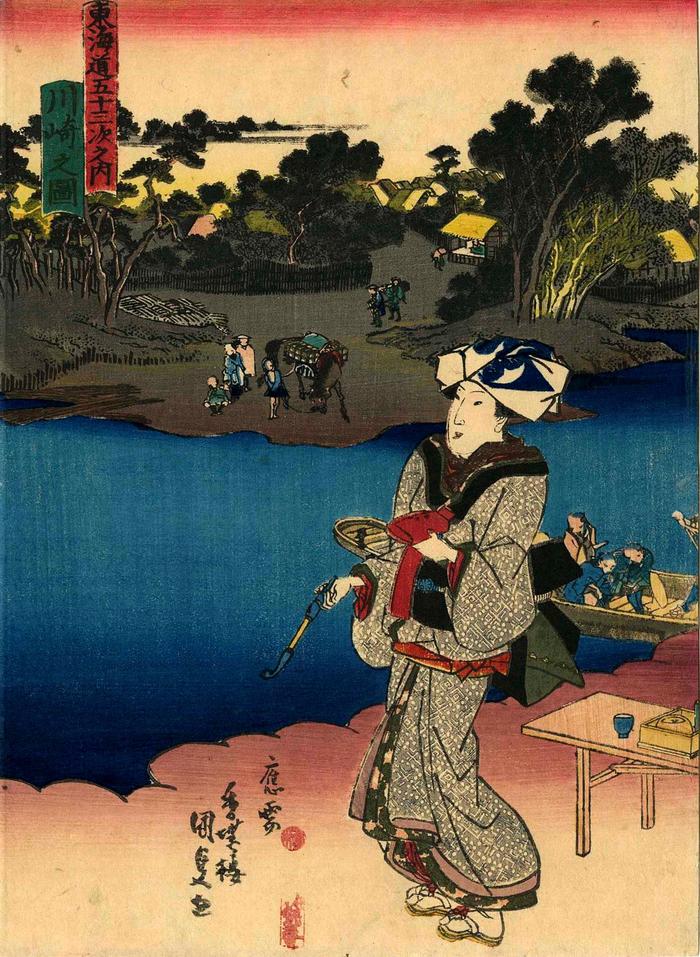Utagawa Kunisada (歌川国貞) / Toyokuni III (三代豊国) (artist 1786 – 01/12/1865)
View of Kawasaki (Kawasaki no zu: 川崎之図) from the series Fifty-three Stations of the Tōkaidō Road (Tōkaidō gojūsan tsugi no uchi: 東海道五十三次之内)
ca 1838
Signed: ōju Kōchōrō Kunisada (応需香蝶楼国貞)
Publisher: Sanoya Kihei
Censor's seal: kiwame
Museum of Fine Arts, Boston - published by Moriya Jihei and Sanoya Kihei
National Diet Library - published by both Moriya Jihei and Sanoya Kihei
Museum für angewandte Kunst, Vienna
Museum of Fine Arts, Boston - Hiroshige's version with a ferry - Kawasaki: The Rokugō Ferry (川崎 六郷渡船)
Ishikawa Prefectural Museum of Art - they date their copy to 1836
Bryn Mawr
Honolulu Museum of Art
The Spencer Museum of Art
Hokkaido Museum of Art
Muzeum Narodowe w Warszawie
Fujisawa Ukiyo-e Museum
Victoria and Albert Museum
Nelson-Atkins Museum of Art All of the prints in this series are chūban sized. The example of this print in the collection of the Museum of Fine Arts in Boston is 10 1/4 x 7 5/16 in. This one in the Lyon Collection is fractionally smaller because it has been trimmed slightly at the bottom and along the right and left hand sides.
****
This is number three in the series. In the Kunisada version the placement of the beauty in the foreground, slightly to the right-hand side, ties together both sides of the river. This is different than Hiroshige variant in which a ferry loaded with six people and the boatman and which dominates the center of his print serves that same function.
Off to the right in both prints shows a figure seated on a raised platform under a thatched roof. This most likely is the ticket seller.
****
We all know that there is a connection between Hiroshige's version of this crossing and the one designed by Kunisada. However, in the Kunisada example a large image of a bijin dominates the foreground and blocks much of what Hiroshige created showing a group of passengers being transported on the ferry. In Hiroshige's print it shows a woman standing in the boat wearing a tenugui on her head protecting her hair. One source says this is a style that dates back to the Muromachi period and is referred to as a katsuramaki. What interests us here the most is that Kunisada's bijin is also wearing the same covering as the woman in the Hiroshige print that has been blocked from our view. A subtle homage, nonetheless.
Another difference between the two compositions is that the Hiroshige shows a palanquin on the far shore with a woman seated inside. However, it may also be much like a taxi waiting to pick up the next fare for carrying a new client to the nearby Buddhist temple, the Kawasaki Daishi.
The boat in the Hiroshige print has been referred to as an uma-watari-bune (馬渡船) or a craft used for ferrying horses across a river.
****
In Tokaido Landscapes: The Path from Hiroshige to Contemporary Artists, 2011, #3, p. 15, speaking of the original Hiroshige print it says in a text by Sasaki Moritoshi: "The scene of the crossing of the Tama River on a ferry boat, with the toward Kawasaki from the direction of Shinagawa."
****
The waters were shallow enough at this point in the journey that there was no need to build a bridge, but deep enough to require the use of a ferry-boat.
****
In Masterworks of Ukiyo-e: Hiroshige, the 53 Stations of the Tōkaidō by Muneshige Narazaki. 1969, p. 30 it says: "For Edoites, this ferryboat ride marked the point at which they entered a "foreign" land; for those coming down to Edo, it signified the end of their journey."
The tollhouse, seen directly above the head of Kunisada's bijin also appears in the Hiroshige print. Other than that Kunisada has changed any number of other elements originally found in the Hiroshige.
Kawasaki is about 5½ miles south of Shinagawa. If you click on this print and enlarge it, you will notice a man waiting with a horse to board the ferry when it arrives on his side of the river. This is an element that Kunisada kept from Hiroshige's version.
****
Illustrated in two small color reproductions in Kunisada's Tokaido: Riddles in Japanese Woodblock Prints by Andreas Marks, Hotei Publishing, 2013, on pages 62 and 63 separately, T24-03.
Sanoya Kihei (佐野屋喜兵衛) (publisher)
landscape prints (fūkeiga 風景画) (genre)
beautiful woman picture (bijin-ga - 美人画) (genre)
